

CentOS 6 Setup with LDAP - azurvii.blogspot.com (HTTP) A Proposal for Secure Storage of Credit Card Data. We were asked by a company in the retailing/catalog business how they might secure their customer credit card data, and we were surprised not to find any obvious references to this other than what happens if you don't.
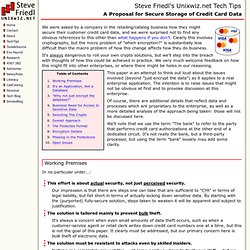
Clearly this involves cryptography, but the micro problem of "which encryption? " is substantially less difficult than the macro problem of how this change affects how they do business. It's always dangerous to roll your own crypto solutions, but we'll step into the breach with thoughts of how this could be achieved in practice. We very much welcome feedback on how this might fit into other enterprises, or where there might be holes in our reasoning. This paper is an attempt to think out loud about the issues involved (beyond "just encrypt the data") as it applies to a real enterprise application. We'll note that we use the term "The bank" to refer to the party that performs credit card authorizations at the other end of a dedicated circuit. Updating Samba-3 with Minimal Pain and User Frustration > Introduction.
Upgrading your Samba installation can be a complicated business, but this chapter will make the process as easy as possible, clarifying some of the muddier aspects of Samba migration.

It was a little difficult to select an appropriate title for this chapter. From email messages on the Samba mailing lists it is clear that many people consider the updating and upgrading of Samba to be a migration matter. Others talk about migrating Samba servers when in fact the issue at hand is one of installing a new Samba server to replace an older existing Samba server.
Chapter 11. Account Information Databases. Early releases of Samba-3 implemented new capability to work concurrently with multiple account backends.
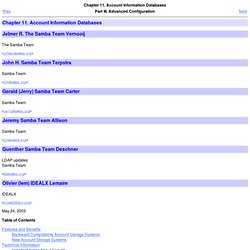
This capability was removed beginning with release of Samba 3.0.23. Commencing with Samba 3.0.23 it is possible to work with only one specified passwd backend. The three passdb backends that are fully maintained (actively supported) by the Samba Team are: smbpasswd (being obsoleted), tdbsam (a tdb-based binary file format), and ldapsam (LDAP directory). Of these, only the ldapsam backend stores both POSIX (UNIX) and Samba user and group account information in a single repository. The smbpasswd and tdbsam backends store only Samba user accounts. In a strict sense, there are three supported account storage and access systems. In a strict and literal sense, the passdb backends are account storage mechanisms (or methods) alone. Old Windows clients send plaintext passwords over the wire. Many people ask why Samba cannot simply use the UNIX password database. Openfire XMPP server.
The Igniterealtime Community is pleased to announce that the release of Openfire version 3.9.2 is available for download!

Openfire is a real time collaboration (RTC) server licensed under the Open Source Apache license. It uses the only widely adopted open protocol for instant messaging, XMPP (also called Jabber). Openfire is incredibly easy to setup and administer, but offers rock-solid security and performance. This release contains a large number of fixes (70 Jira issues resolved) aimed at increasing stability, security and XMPP standards compliance. OpenFire: Hide all users in the same group from each other.
Openfire 3.6.4 API. GroupProvider (Openfire 3.6.4 Javadoc) All Known Implementing Classes: AbstractGroupProvider, ClearspaceGroupProvider, CrowdGroupProvider, DefaultGroupProvider, JDBCGroupProvider, LdapGroupProvider public interface GroupProvider.
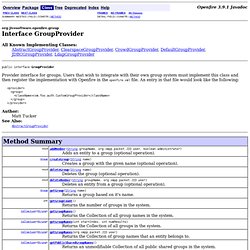
Configuring LDAP. Introduction This document details how to configure your Openfire installation to use an external directory such as Open LDAP or Active Directory.
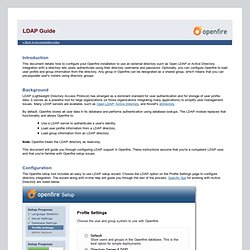
Integration with a directory lets users authenticate using their directory username and password. Optionally, you can configure Openfire to load user profile and group information from the directory. Any group in Openfire can be designated as a shared group, which means that you can pre-populate user's rosters using directory groups. Background. Openfire Properties. Be your own Certificate Authority (CA) I declare from the beginning that I am no authority on digital certificates.

This document is a summary of all the articles I have read about openssl. It describes in short how to become your own Certificate Authority (CA) and how to create and sign your own certificate requests. Make no mistake, these certificates are good only for personal use or for use in your intranet in order to provide a secure way to login or communicate with your services, so that passwords or other data is not transmitted in the clear.
Noone else will or should trust these certificates. Prerequisites The package openssl should be installed in the machine you will use to manage your certificates or create the certificate requests. First things first… Creating the necessary directories First of all we will create a directory tree where all certificate stuff will be kept. . # mkdir -m 0755 /etc/pki_jungle And then we create our CA’s directory tree: Puppet - Automated System administration.
Zmanda backup and recovery. Zmanda Recovery Manager for MySQL Zmanda Recovery Manager (ZRM) for MySQL simplifies the life of a Database Administrator who needs an easy-to-use yet flexible and robust backup and recovery solution for MySQL server.

Quick MySQL Backup Setup — How to Backup MySQL. This setup was performed using ZRM version 1.1.

To learn how to set up the latest version of ZRM 2.1 on Fedora Core 8 for MySQL 5.0, please register on Zmanda Network and read "How to set up and verify automated MySQL backups in 15 minutes" white paper in the Resources section of Zmanda Network. The Problem The value of data stored in MySQL grows exponentially. For companies who are using MySQL in production, loss of data can be catastrophic, resulting in lost revenues, lost customers and lost reputations. Setting up MySQL backup and restore processes typically takes up a lot of a DBA's time and attention. The Challenge. Quartz Scheduler - Documentation - Quick Start Guide. (Primarily authored by Dafydd James) Welcome to the QuickStart guide for Quartz.
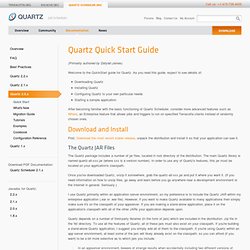
As you read this guide, expect to see details of: Downloading QuartzInstalling QuartzConfiguring Quartz to your own particular needsStarting a sample application After becoming familiar with the basic functioning of Quartz Scheduler, consider more advanced features such as Where, an Enterprise feature that allows jobs and triggers to run on specified Terracotta clients instead of randomly chosen ones. Download and Install First, Download the most recent stable release, unpack the distribution and install it so that your application can see it. The Quartz JAR Files The Quartz package includes a number of jar files, located in root directory of the distribution.
Memcached - distributed object caching. PhpMyAdmin. 16.1.1 How to Set Up Replication. Opsview. Nagios Plugin API. Up To: Contents See Also: Plugin Overview, Developing Plugins For Use With Embedded Perl, Performance Data Other Resources If you're looking at writing your own plugins for Nagios, please make sure to visit these other resources: Plugin Overview Scripts and executables must do two things (at a minimum) in order to function as Nagios plugins: Exit with one of several possible return values Return at least one line of text output to STDOUT The inner workings of your plugin are unimportant to Nagios.
Return Code Nagios determines the status of a host or service by evaluating the return code from plugins. Note: If the use_aggressive_host_checking option is enabled, return codes of 1 will result in a host state of DOWN or UNREACHABLE. Plugin Output Spec. Nagios plug-in output. 1. Development platform requirements Nagios Plugins are developed to the GNU standard, so any OS which is supported by GNU should run the plugins. While the requirements for compiling the Nagios Plugins release are very basic, developing from the Git repository requires additional software to be installed. These are the minimum levels of software required: